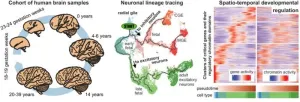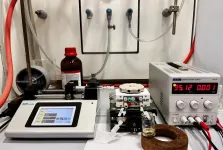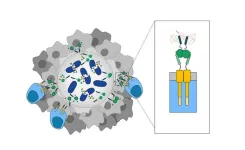(Press-News.org) A longstanding mystery in science is how the over 100 million individual neurons work together to form a network that forms the basis of who we are – every human thought, emotion and behavior.
Mapping these constellations of cells and discovering their function have been long-standing goals of scores of 21st century molecular cartographers working worldwide as part of the National Institutes of Health’s “Brain Initiative Cell Census Network” project. The overarching purpose of the atlas is to aid in the development of neuroscience research. The hope of the project is that it will allow scientists to gain a better understanding of brain diseases and hard to solve medical mysteries behind disorders such as autism and depression.
Now, a series of new studies published today has revealed the widespread profiles of the inner molecular workings of the brain at an unprecedented level and scale.
As part of the effort to better understand the evolution of the brains in people and animals, a research team led by scientists at Arizona State University, University of Pennsylvania, the University of Washington, and the Brotman Baty Institute generated the world’s largest primate brain-wide atlas.
“Mapping what cells are where and what they do in the adult primate brain is crucial both for understanding the evolution of human cognition and behavior as well as for identifying what happens when things go wrong and lead to neurological disorders,” said senior co-author Noah Snyder-Mackler, an associate professor at Arizona State University’s School of Life Sciences and Center for Evolution and Medicine.
Their goal was to identify and examine many of the brain cells (neurons and non-neurons) and perform a complete molecular analysis using state-of-the-art single-cell technologies.
To do so, they used samples from 30 different brain regions to draw out and build up, cell by cell, a new atlas. Altogether, the final map was composed of a 4.2 million cellular atlas of the adult primate brain.
“Our data, which we have made open and available to the scientific community and broader public, represent the largest and most comprehensive multimodal molecular atlas in a primate to date, and are crucial for exploring how the many cells of the brain come together to give rise to the behavioral complexity of primates including humans,” said senior co-author Jay Shendure, a professor of Genome Sciences at the University of Washington and Director of the Brotman Baty Institute.
“These data will also provide a critical and much-needed map of complex human-relevant social behavior and disease, as well as the substrate for identifying similarities and differences in these cells and networks across species,” said senior co-author Michael Platt, a professor in the Departments of Neuroscience, Psychology, and Marketing at the University of Pennsylvania
For every cell nucleus, the scientists profiled gene expression (2.58 million transcriptomes) and a suite of complementary DNA gene regulatory regions (1.59 million epigenomes). Taken together, this type of “multi-omic” analysis allowed the authors to study the molecular blueprints that make up distinct brain cell types, thus providing an opportunity to study, and even manipulate, key cells in more detail.
From the gene expression profiles, there were able to identify hundreds of molecularly distinct brain cell types. They also found that cell composition differed extensively across the brain, revealing cellular signatures of region-specific functions, from the neurotransmitters involved in brain cell communication to support cells that help feed and protect the brain from diseases like Alzheimer’s.
They used their data to investigate a total of 53 phenotypes relevant to risk of neurological diseases, disorders, syndromes, behaviors, or other traits. Their results captured known roles of cell classes implicated in neurological diseases, including cells linked to cardioembolic stroke or ischemic stroke, the leading cause of neurological death in people.
They also found that genes linked to Alzheimer’s disease tended to fall within DNA regulatory regions that are only accessible in microglia—the brain’s primary immune cell that protects neurons—consistent with the prominent role of microglia proliferation and activation in Alzheimer’s disease found from genome-wide association studies (GWAS).
Many of the regulatory regions they identified were new, which allowed the team to explore the genetic architecture of neurological disease risk at the cellular level. “We identified numerous associations between genetic risk for neurological disorders and the epigenomic states of specific cell types–some of which had yet to be connected,” said co-lead author Kenneth Chiou, postdoc in the Center for Evolution and Medicine and School of Life Sciences at ASU.
Another type of cell class, basket cells, were enriched for the greatest number of GWAS phenotypes, including disorders such as schizophrenia, bipolar disorder, major depressive disorder and, most strongly, epilepsy. They also found enrichment of Parkinson’s disease-associated sites among open regions in the glial OPC, oligodendrocyte, and astrocyte cell classes.
Finally, they found that heritable sites associated with attention deficit/hyperactivity disorder (ADHD) in their analysis were enriched only among open regions of medium spiny neurons. Medium spiny neurons have been linked to behavioral hyperactivity and disrupted attention via activation of astrocyte-mediated synaptogenesis. Their results suggest that medium spiny neurons may be a promising new target for future ADHD-related study.
Together, “multi-omic” atlas now provides an open resource to the worldwide research community for further investigations into the evolution of the human brain and identifying novel targets for disease interventions.
END
Scientists generate first single-cell “atlas” of the primate brain to help explore links between molecules, cells, brain function and disease
More than 4 million cells profiled to make largest atlas to date to help explore the evolution of the human brain and new targets for disease and treatments
2023-10-12
ELSE PRESS RELEASES FROM THIS DATE:
Researchers construct first “multiome” atlas of cell development in the human cerebral cortex from before birth to adulthood
2023-10-12
A team of researchers from the Icahn School of Medicine at Mount Sinai and Yale University School of Medicine has created the first “multiome” atlas of brain cell development in the human cerebral cortex across six broad developmental time points from fetal development into adulthood, shedding new light on their roles during brain development and disease.
“Multiome” refers to the simultaneous analysis of multiple types of genetic information within the same biological sample. They can include the genome, the DNA encoded in our cells; the transcriptome, the RNA copies that the cell makes from the ...
Boom-and-bust cycles in grey whale population associated with changing Arctic ecosystem
2023-10-12
Even highly mobile, large, and long-lived species are sensitive to dynamic and changing conditions as the Arctic warms. A new study reports that population swings in eastern North Pacific grey whales – some of which have resulted in recent mass mortality events – are driven by changing prey biomass and ice cover in the Arctic. Climate change is driving rapid change in Arctic ecosystems, including the highly productive shallow basins of the Pacific Arctic, which are critical marine areas that support seasonal foraging opportunities for various migratory marine species. While climate impacts affect lower-trophic level and short-lived species most directly, ...
About 2 million years ago, Homo Erectus lived at high altitudes and produced both Oldowan and Acheulean tools
2023-10-12
Two million years ago, Homo erectus had expanded beyond the lowland savanna environments of East Africa and into the high-altitude regions of the Ethiopian highlands, where they produced both Oldowan and Acheulean tools, according to a new study. It presents a reanalysis of an early hominin fossil first discovered in 1981. The findings provide novel insights into the evolution, migration and adaptive capacities of early human ancestors. In Africa, the limited number of hominin fossils found in direct association with stone tools has hindered attempts to link Homo habilis and Homo erectus with ...
Engineered bacteria guide CAR-T cells to poorly infiltrated solid tumors
2023-10-12
A new probiotic-guided chimeric antigen receptor (CAR)-T platform uses engineered bacteria to infiltrate and produce synthetic antigen targets, enabling CAR-T cells to find, identify, and destroy tumor cells in situ, according to a new study. The combined cell therapy platform expands the scope of CAR-T cell therapy to include difficult-to-target solid tumors. Immunotherapies using CAR-T cells have proven successful in treating some types of blood cancers. However, their efficacy against solid tumors remains elusive. A key challenge facing tumor-antigen targeting immunotherapies like CAR-T is the identification of suitable ...
An electrical switch to control chemical reactions
2023-10-12
New pharmaceuticals, cleaner fuels, biodegradable plastics: in order to meet society’s needs, chemists have to develop new synthesis methods to obtain new products that do not exist in their natural state. A research group at the University of Geneva (UNIGE), in collaboration with Cardiff University, has discovered how to use an external electric field to control and accelerate a chemical reaction, like a ‘‘switch’’. This work, to be read in Science Advances, could have a considerable impact on the development of new molecules, enabling not only more environmentally friendly synthesis, but also very simple external control of a chemical reaction.
In ...
Gray whales experience major population swings as a result of Arctic conditions, research shows
2023-10-12
NEWPORT, Ore. – Dynamic and changing Arctic Ocean conditions likely caused three major mortality events in the eastern North Pacific gray whale population since the 1980s, a new study has found.
During each of these die-offs, including one that began in 2019 and is ongoing, the gray whale population was reduced by up to 25% over just a few years, said Joshua Stewart, an assistant professor with Oregon State University’s Marine Mammal Institute and the study’s lead author.
“These are extreme population swings that we did not expect to see in a large, long-lived species like gray whales,” Stewart said. “When the availability ...
Cell atlases of the human brain presented in Science
2023-10-12
In two parallel projects, researchers at Karolinska Institutet have been involved in creating the most comprehensive atlases of human brain cells to date. The two studies, which are published in Science, provide clues on different brain diseases and give hope for medical advancements in the future, such as new cancer drugs.
Knowing what cells constitute the healthy brain, where different cell types are located and how the brain develops from the embryo stage is fundamental to the ability to compare and better understand how diseases arise. There are at present advanced atlases of the ...
Coffee and cocoa plants at risk from pollinator loss
2023-10-12
Tropical crops such as coffee, cocoa, watermelon and mango may be at risk due to the loss of insect pollinators, finds a new study led by UCL and Natural History Museum researchers.
Published in Science Advances, the study explores the intricate interplay between climate change, land use change, and their impact on pollinator biodiversity, ultimately revealing significant implications for global crop pollination.
The study, which compiled data from 1,507 crop growing sites around the world and catalogued 3,080 insect pollinator species, exposes a concerning trend – the combined pressures ...
Scientists unveil detailed cell maps of the human brain and the nonhuman primate brain
2023-10-12
A group of international scientists have mapped the genetic, cellular, and structural makeup of the human brain and the nonhuman primate brain. This understanding of brain structure, achieved by funding through the National Institutes of Health’s Brain Research Through Advancing Innovative Neurotechnologies® Initiative, or The BRAIN Initiative®, allows for a deeper knowledge of the cellular basis of brain function and dysfunction, helping pave the way for a new generation of precision therapeutics for people with mental disorders and other disorders of the brain. The findings appear in a compendium of ...
Engineered bacteria paint targets on tumors for cancer-killing T cells to see
2023-10-12
New York, NY—October 12, 2023—For several years, researchers have been successfully using chimeric antigen receptor (CAR) T cells to target specific antigens found on blood cells as a cure for patients with leukemia and lymphoma. But solid tumors, like breast and colon cancers, have proven to be more difficult to home in on. Solid tumors contain a mix of cells that display different antigens on their surface-often shared with healthy cells in the body. Thus, identifying a consistent and safe target has impeded the success of most CAR-T cell therapy for solid tumors at the first phase ...
LAST 30 PRESS RELEASES:
American Meteorological Society announces new executive director
People with “binge-watching addiction” are more likely to be lonely
Wild potato follows a path to domestication in the American Southwest
General climate advocacy ad campaign received more public engagement compared to more-tailored ad campaign promoting sustainable fashion
Medical LLMs may show real-world potential in identifying individuals with major depressive disorder using WhatsApp voice note recordings
Early translational study supports the role of high-dose inhaled nitric oxide as a potential antimicrobial therapy
AI can predict preemies’ path, Stanford Medicine-led study shows
A wild potato that changed the story of agriculture in the American Southwest
Cancer’s super-enhancers may set the map for DNA breaks and repair: A key clue to why tumors become aggressive and genetically unstable
Prehistoric tool made from elephant bone is the oldest discovered in Europe
Mineralized dental plaque from the Iron Age provides insight into the diet of the Scythians
Salty facts: takeaways have more salt than labels claim
When scientists build nanoscale architecture to solve textile and pharmaceutical industry challenges
Massive cloud with metallic winds discovered orbiting mystery object
Old diseases return as settlement pushes into the Amazon rainforest
Takeaways are used to reward and console – study
Velocity gradients key to explaining large-scale magnetic field structure
Bird retinas function without oxygen – solving a centuries-old biological mystery
Pregnancy- and abortion-related mortality in the US, 2018-2021
Global burden of violence against transgender and gender-diverse adults
Generative AI use and depressive symptoms among US adults
Antibiotic therapy for uncomplicated acute appendicitis
Childhood ADHD linked to midlife physical health problems
Patients struggle to measure blood pressure at home
A new method to unlock vast lithium stores
Scientists unveil “dissolution barocaloric” cooling, opening new path to zero-carbon refrigeration
Microplastics in the atmosphere: Higher emissions from land areas than from the ocean
Metal clumps in quantum state: Vienna research team breaks records
PolyU develops new human-safe magnetorheological fibres, leading innovations in smart wearable textiles
Rice establishes Global Brain Economy Initiative in Davos, aligned with new report on brain health and AI
[Press-News.org] Scientists generate first single-cell “atlas” of the primate brain to help explore links between molecules, cells, brain function and diseaseMore than 4 million cells profiled to make largest atlas to date to help explore the evolution of the human brain and new targets for disease and treatments



